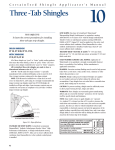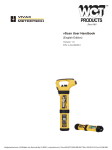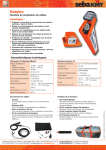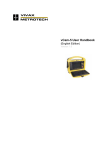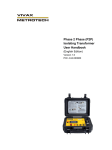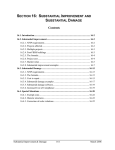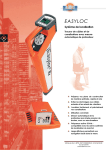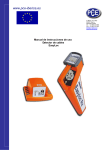Download Locating Conduit for Roofing Application
Transcript
Locating Conduit for Roofing Application (Using Metrotech Easyloc Locating System) Overview. We have found the Easyloc underground pipe and cable locating system to be an effective locator for roof-top applications such as commercial re-roofing. Re-roofing contractors are always looking for a method to avoid hitting the wires, conduit and steel beams underneath the decking when they drive in screws to secure a new roof. The Vivax-Metrotech Easyloc is optimally designed for locating conductors and works well for this purpose. The Easyloc system consists of a hand-held receiver (Rx) and a transmitter (Tx). The Easyloc Rx receiver is effective in either the passive or active modes. The Transmitter (Tx) provides added benefits but is not required for the Easyloc to be useful in most re-roofing applications. We will describe the best procedures for using the product below. Common User Needs for Re-roofing jobs • Avoiding conduit with live power, inactive power, low-voltage D.C., CATV, and telecom. You may not know exactly what is under the roof, but you probably want to avoid all of it. • Avoiding the steel beams under the roof. • Usually avoidance is the primary goal but you may also be interested in the depth feature. Using the Easyloc Rx in Passive Mode. Recommended steps: • Start in the POWER mode. •Perform a standard grid pattern sweep of the area. •When a conductor is identified, pinpoint the location by adjusting the gain to determine the location of the strongest peak signal at the lowest possible gain. “Mark” the area so that later you can avoid drilling into the known power conduit. Avoid drilling at least 3-6 inches on either side of the (Marked) peak signal along the length of the conductor. The exact area to mark will depend on how much space is available and what each roofer is comfortable with. It is certainly OK to mark the area further away than 3-6 inches if that is preferred for added security. • Repeat sweeping a standard grid pattern as described above but this time in RADIO mode (Also see drawing below). •If you find an additional conductor in RADIO mode, it could be a variety of other items to avoid, including inactive power (Conduit not in use at the moment), steel beams, low-voltage D.C., CATV, or telecom. Always pinpoint the location, and “mark” the area in the same manner as in POWER mode. • A weaker signal in any of the modes (POWER, or RADIO) could indicate that the conductor is located further away or below the roof decking, or it could indicate that the conductor is close to the roof deck but has less current flow and generates a weaker magnetic field. In order to be safe ALWAYS mark these conductors for avoidance as well. Using the Easyloc Rx and Tx in Active Mode. We recommend following these steps: •Use the House Connection Kit for direct connect to the building •Before going on the roof, plug the HCK into any convenient outlet in the building or on an exterior wall •Select a suitable frequency. On any reroofing job, ALWAYS use two different frequencies to verify results. Use 8.44kHz on the first sweep and then use 32.768kHz on the second sweep. •Set the Easyloc Tx in Pulsed Mode (very important) •Set the Easyloc Rx receiver in the same frequency as the Tx and repeat the same steps described in Passive mode above, starting with the standard grid search •In active mode you will identify the pulsing Tx signal on any conductors that are common bonded in the building. When any conductor is located in active mode, “mark” the area for avoidance using the same procedure described for Power and Radio modes above • Once in the Active (Frequency) mode you can also obtain a depth estimate. Note of caution: on measuring depth the user manual states, “For best accuracy use the Easyloc transmitter in continuous mode (it is possible to perform depth measurements with the Tx set to pulse mode but a slight reduction in accuracy may be experienced).” Switch the Tx to continuous mode for the most precise depth estimate. Depth is based on internal instrument calculations and is always approximate, and should be treated as such. When is it Best to Use Passive and Active Modes? Passive mode provides a number of benefits to the roofer: (Using only the Easyloc receiver) • It is the most cost effective way to avoid damage • It is simpler and easier to use • It will locate live circuits in Power mode • It will locate inactive circuits, steel beams, and other conductors in Radio mode The Active mode provides these additional benefits: (Using both the Easyloc receiver and transmitter) • You get a stronger signal on inactive circuits • Better differentiation in types of conductors • Approximate depth of conductor • The pulsing signal is clearly identified




